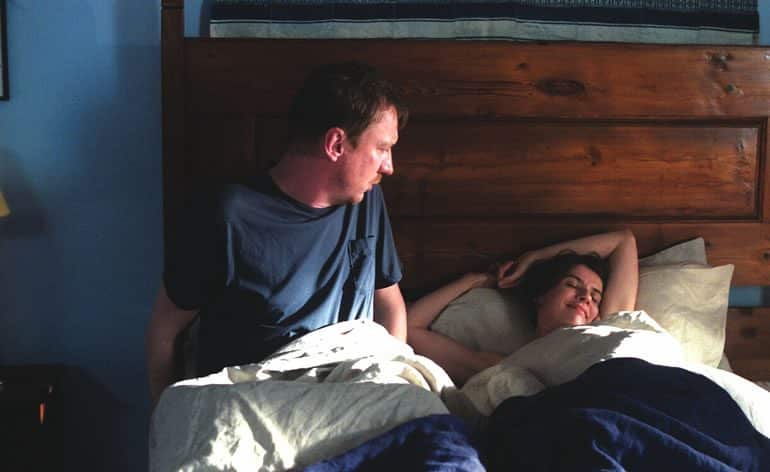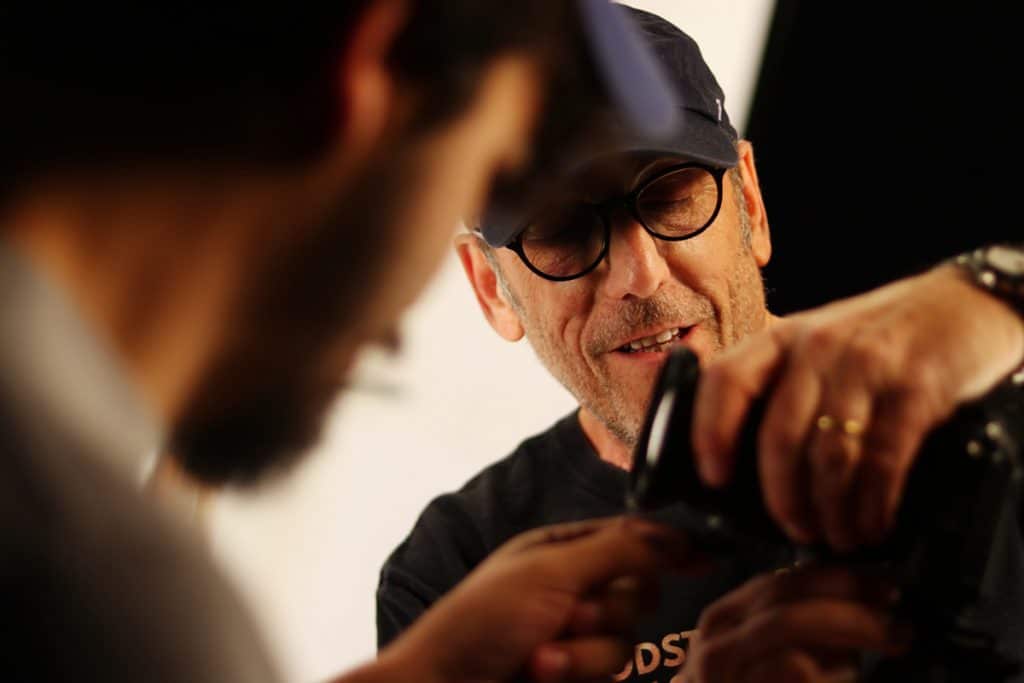A Conversation with Award-Winning Writer and Director Paul Auster: The Inner Life of Martin Frost Premieres at the IFC Center in New York City Interview by Jody Michelle Solis.
The Inner Life of Martin Frost appears partially in narrative form in award-winning author Paul Auster’s best-selling novel, “The Book of Illusions.” The story now comes to life in the new feature film, a philosophical mystery, written and directed by Paul Auster, and starring David Thewlis, Irène Jacob, Michael Imperioli, and Sophie Auster.
The story centers on writer Martin Frost, who just after settling into a friend’s empty house, gets a new idea for a story, and the next day discovers a beautiful woman, Claire, sharing the house with him. The two fall in love, but is Claire really the person she claims to be?
The Inner Life of Martin Frost is an official selection of the San Sebastian International Film Festival and opening night selection of the New Directors/New Films Festival. The movie premieres at the IFC Center in New York City on Friday, September 7.
Paul Auster speaks with StudentFilmmakers magazine about the making of Martin Frost, getting distribution for his film, and shares some of his insights and experiences after returning to the director’s chair.
I read a personal quote from you that says, “Becoming a writer is not a career decision like becoming a doctor or a policeman. You don’t choose it so much as get chosen, and once you accept the fact that you’re not fit for anything else, you have to be prepared to walk a long, hard road for the rest of your days.” Could you explain what this means, ‘to walk a long, hard road’?
Paul Auster: Well, I suppose it has to do with many things all at once. In the beginning, there’s the pressure you put on yourself to try to produce work that you feel is decent, good, valuable. Then there’s the difficulty of trying to get published in the beginning, if anybody else thinks that what you’ve done has any merit at all. And then, of course, there are the financial problems. People get lucky, but you certainly can’t count on it.
Could you give us an example from your own experience?
PA: Well, to make a very long story short, I could just tell you that I started writing as a teenager in high school, but I never actually made any money for writing – any money that was of any significance until I was forty years old. So I was doing many other things to support myself. And sometimes, I was really quite desperately poor, I have to say.
Would you say that any changes have taken place in the industry over the years? Is it still the same for a writer nowadays?
PA: I think the culture’s changed. I think there is a kind of dumbing down of American life, as everyone says, and I tend to agree with it. If you take, for example, the New York Times Book Review, back in the old days when I was starting out, it was sixty-four to eighty pages a week. And now, it’s usually about sixteen. So, coverage of books has diminished considerably, and publishing itself has become more and more commercial. The transit isn’t so encouraging, but at the same time, there are good writers all over the place. So, it’s not as grim as it might be, but certainly, things have changed, there’s no question about it.
How did you make the transition from author to film director?
PA: Well, I always loved movies starting from childhood. At one point, when I was about eighteen or nineteen, I thought maybe I should become a film director. I was actually thinking about going to film school. But as I realized that I was so shy at that point, I could barely speak to anybody – I could speak one-on-one with people but never in groups – and I thought, well, how can I be a film director if I can’t communicate with anybody? So, I gave up the idea, but I continued to be a maniac for watching film. Then, ironically enough, when I started publishing novels, filmmakers started contacting me, either to adapt works of mine, or to write screenplays for them.
I guess the real step forward was working with Wayne Wang on two films, Smoke and Blue in the Face, which we made together. I wrote Smoke, and he directed it, but we were co-filmmakers in the sense that we did all the pre-production together, we did all the rehearsals together, and we did all the post production together – editing, music, credits, everything. So, working on that film with Wayne was like going to film school. I learned an awful lot. And, I became a director by accident.
We started making our second film, Blue in the Face, right after Smoke. We finished Smoke on a Friday; we started Blue in the Face the next Monday. But it was a very hot summer – stifling heat. Wayne got sick, and so he couldn’t come to the set. Suddenly, he calls and he says, Paul, you take over, you can do it. And so, I just did it, and it was a remarkable experience; and I loved it.
My second experience directing – Lulu on the Bridge, which was in ’97 and ’98 – I originally wrote the screenplay for Wim Wenders to direct. But then, Wim had a conflict; he couldn’t do it. We talked about it, and he said, you know, you should direct it yourself, you’re perfectly capable of doing it. And so, I went along with it. I said, okay, I’m gonna try. I’m gonna do it. And I had a wonderful time, I must say. It was a great experience for me.
And then, I took a long pause from film, and now I’ve made this new film, The Inner Life of Martin Frost.
How would you describe your process for writing The Inner Life of Martin Frost?
PA: Well, I don’t know. It’s like any piece of writing. You sit there, and you let your imagination go, and hope that something interesting is going to happen.
How did you cast for The Inner Life of Martin Frost? Did you write the script with David Thewlis, Irène Jacob, Michael Imperioli, and your daughter, Sophie Auster, in mind?
PA: Well, I actually had Irène Jacob in mind because just before I started writing the script, I knew I was going to write it, but I hadn’t started yet. I went to France, and I did a reading to her; in Paris, she read with me. And, I had met her before. I knew her a little bit. She read the French translation, and I would read the English the night before we would go to the theatre where the reading was held. A couple of nights later, we went out together, and it was raining, I remember, and she had a car. She was eight months pregnant at the time, too. She could barely get in behind the wheel. And, I looked over at her in the car, and I said to myself, this is Claire; this is my character. This is the person to play the part. And so, I told her about the start of the film script, and would she be interested in reading it when I’m finish. She said, of course. I was very, very happy when she said yes. She was the first one who got it.
Michael Imperioli; interesting case there, too. Because he auditioned for Smoke back in 1994, and I was very impressed with him, but he was too young for the part. So, we didn’t cast him in the film. Two years later, when I did Lulu on the Bridge, I cast Michael in a small part. But then, before we started filming, he got a bigger part in another movie. And the deal was, well, if you have a little part in one thing, you got a bigger one in another – you let the actor go. So I let Michael go. But still, always in the back of my mind, I wanted to work with him somehow. And when I wrote the script, I gave it to him first for the part of Fortunato. Luckily, he too said yes right away. One day later he called.
And, finally, the same as David Thewlis. We had another actor who was going to do it. I can’t say who, but he backed out at the last minute for very complicated personal reasons. And so, I was stuck. I was leaving for Portugal in two weeks, and I didn’t have a lead actor. I sat down and thought to myself, who would I really want? If I could pick any English-speaking actor in the world, who do I think would be the best to do this part? And I said to myself, David Thewlis. We met once about eight or nine years before. We’ve had a nice conversation, I knew he read my books and liked them; but I didn’t know how to get in touch with him. I called a casting person, Heidi Levitt, who worked on Smoke, Blue in the Face, and Lulu with me in LA; and I asked Heidi if she can get me David’s telephone number. I couldn’t go through agents because the film had no budget, and no agent would’ve let a client see a script when they realize how little money the client was going to be paid. So I wanted to talk to David directly. It’s a funny story – I called, I left a message, and then he called me back the next day. And he said, ‘It’s so funny because I have been trying to track you down to tell you a funny story about something…’ I thought some friend of mine was playing a prank. So we emailed him the script, and the next day, he called, and he said yes.
It was just miracles, all this casting. And then Sophie, of course, is someone I know extremely well, and I thought she would be perfect for the part because you need someone young, eighteen years old who can act and sing. She is one of the few people of that age, I think, who can do it; and she did a really good job, I think. So casting turned out to be one of the least troublesome parts of the movie.
Did any unique challenges come up during production?
PA: Nothing terrible really. We were filming outdoors a lot; we had a lot of problems with sound. Airplanes, dogs, roosters. But we managed to somehow work around those things. Nothing major. I think in all the other movies I’ve worked on, something worse happened. This time, we were blessed.
For example, the lab didn’t mess up any of the film, which happened to me on Lulu on the Bridge. Whole second day of shooting was badly processed. Smoke had different problems. But not this film. Everything went well. We were so tiny; the crew was only about eighteen people. We worked very intensely and very harmoniously together.
What was your most favorite scene to shoot and why?
PA: Ah! What an interesting question. Let me think, let me think. There’s a scene in the middle of the film when Martin has to get a new tire. And so, he’s rolling the tire along the road, and the tire gets away from him. I wanted to make a kind of slapstick comedy scene. We worked very hard on that, and we made it work. We had that tire rolling, rolling, and David running after it. And then, the tire kind of veers off the road, bounces off a rock, and then, bounces back, hits him, and knocks him down. Working out that little stunt – it took me a long time to figure out how to do it. I came up with a very simple solution, and it worked. And you just cut, cut, cut, and the thing worked, and I felt so satisfied that we had pulled it off.
You shot The Inner Life of Martin Frost on video, scene by scene. Could you elaborate on this, your reasons, and how it allowed you to come up with new ideas for blocking and camera set-ups?
PA: This is a crazy experiment that I devised. I don’t know if anyone’s ever done this. But because we had such a small cast, it’s such a limited number of locations, and it was possible to do it. We were rehearsing. Sophie wasn’t there; she was still in college, so she hadn’t come to Portugal yet. We had someone substituting for her. But Michael, Irène, and David were all there. We had been doing very good work, and I thought they were really ready to shoot; and we had one more day of rehearsal. And I said, well, let’s shoot the whole movie in one day. Let’s just see what happens. We’ll do it on video, in order, in sequence because obviously, we couldn’t edit it, so we had to do it scene by scene. And we were running all over the place from one scene to the next. I said it would take us about three hours to do it – it took nine hours. But, certain ideas came to both me and Christophe Beaucarne, the DP, about certain angles of the camera, certain kinds of blocking. Smalls details, but everything mattered. When the character Martin is reading the letter from Claire, who’s mysteriously run away, he just sat down on the tire and leaned his back against the car. I had originally written the scene with him standing with his hand on the roof of the car and his back to the camera. But, watching David just sit down on the tire made me think this is a much better way to approach it. Also, when Irène writes that same letter, I had always imagined her doing it on her lap in the car. But what she did was she leaned forward and wrote it on the dashboard with her face just behind the windshield, and I thought it was a beautiful look to it. So that’s how we blocked out that scene in the film itself. But a lot of little things came from that one crazy day.
How have you seen the area of film distribution change throughout the years?
PA: Well, I’ll tell ya, I don’t have a long history in the movies, but it’s been, let’s see, since ’93 when I finished Smoke, the screenplay. And Wayne and I had started actually been working on it since ’91. So it’s been sixteen years. So that’s actually longer than I would’ve thought. It’s become so much more difficult to make a small, independent film. It’s almost impossible. Back in the good old days when I had my script finished and our producers sent it to Miramax, they said fine – we like it, we’ll give you the money, and we’ll produce the film. Good, just go ahead. This time, I wrote the script, and I sent it around to a number of American distributors hoping to get financing for it – very inexpensive, I mean, this is a minuscule budget. And they all said, it’s very interesting, we like it, but go ahead and make the film, and then show it to us, and maybe we’ll distribute it. I said, well, how can I make the film? I don’t have any money. They said, well, that’s your problem. And that’s why I turned to Paulo Branco, who’s a European producer – someone I’ve known for fifteen years or so. He has an office in Paris and an office in Lisbon. Paulo is a legend in Europe. He’s produced two hundred and thirty movies, if you can imagine, and he’s still in his fifties. He said to me after Lulu on the Bridge – Paul, if you ever want to make another movie, I’ll produce it. Remembering his words, I called him up, sent him the script, and he became the producer. And it just turned out that it was much less expensive to film in Portugal than to do it here in the United States.
You recently received distribution for The Inner Life of Martin Frost. Could you talk a little bit about this, and what was involved?
PA: Well, we were in a festival in New York in March. New Directors/New Films, which is at Museum of Modern Art and Lincoln Center. We were very honored to be the opening night film. I felt very happy about that. And, needless to say, distributors came; and the most enthusiastic response came from Dan Talbot of New Yorker Films, so we went with him. And I’m just grateful that we have somebody. There are so many small films today that do not get distribution at all. And it’s a pity – all the work, all the hard word. So, I feel very lucky.
What advice would you give to aspiring screenwriters and directors?
PA: If you love to do it, just keep doing, and do the best work that you possibly can. It’s a very tough business, and it’s filled with very unsavory people. People you really don’t want to have to deal with that much.
The work itself is such a joy. The spirit of camaraderie. The crew, the actors, all the technicians, the editors. All of these things are so enjoyable that I guess you just have to do the best work you can. All the time. And maintain the highest level possible.





